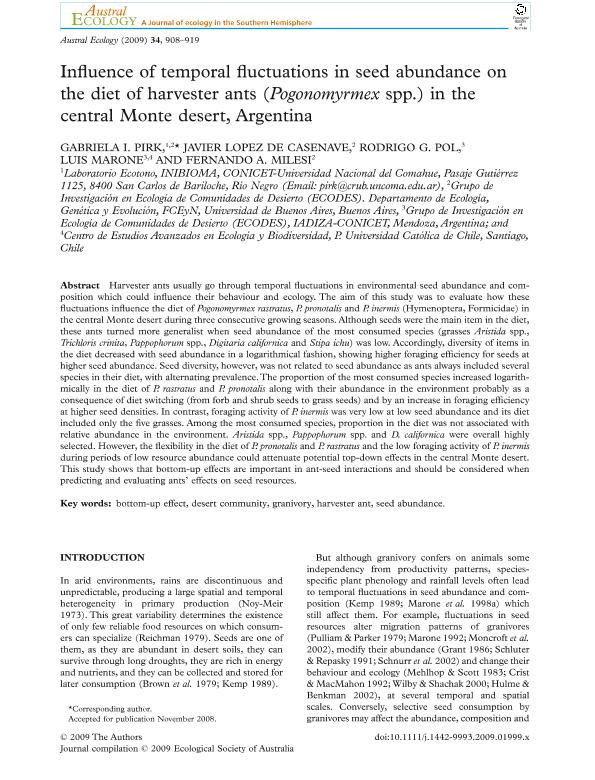Artículo
Influence of temporal fluctuations in seed abundance on the diet of harvester ants (Pogonomyrmex spp.) in the central Monte desert, Argentina
Pirk, Gabriela Inés ; Lopez de Casenave, Javier Nestor
; Lopez de Casenave, Javier Nestor ; Pol, Rodrigo Gabriel
; Pol, Rodrigo Gabriel ; Marone, Luis
; Marone, Luis ; Milesi, Fernando Adrian
; Milesi, Fernando Adrian
 ; Lopez de Casenave, Javier Nestor
; Lopez de Casenave, Javier Nestor ; Pol, Rodrigo Gabriel
; Pol, Rodrigo Gabriel ; Marone, Luis
; Marone, Luis ; Milesi, Fernando Adrian
; Milesi, Fernando Adrian
Fecha de publicación:
19/12/2009
Editorial:
Wiley Blackwell Publishing, Inc
Revista:
Austral Ecology
ISSN:
1442-9985
Idioma:
Inglés
Tipo de recurso:
Artículo publicado
Clasificación temática:
Resumen
Harvester ants usually go through temporal fluctuations in environmental seed abundance and composition which could influence their behaviour and ecology. The aim of this study was to evaluate how these fluctuations influence the diet of Pogonomyrmex rastratus, P. pronotalis and P. inermis (Hymenoptera, Formicidae) in the central Monte desert during three consecutive growing seasons. Although seeds were the main item in the diet, these ants turned more generalist when seed abundance of the most consumed species (grasses Aristida spp., Trichloris crinita, Pappophorum spp., Digitaria californica and Stipa ichu) was low. Accordingly, diversity of items in the diet decreased with seed abundance in a logarithmical fashion, showing higher foraging efficiency for seeds at higher seed abundance. Seed diversity, however, was not related to seed abundance as ants always included several species in their diet, with alternating prevalence. The proportion of the most consumed species increased logarithmically in the diet of P. rastratus and P. pronotalis along with their abundance in the environment probably as a consequence of diet switching (from forb and shrub seeds to grass seeds) and by an increase in foraging efficiency at higher seed densities. In contrast, foraging activity of P. inermis was very low at low seed abundance and its diet included only the five grasses. Among the most consumed species, proportion in the diet was not associated with relative abundance in the environment. Aristida spp., Pappophorum spp. and D. californica were overall highly selected. However, the flexibility in the diet of P. pronotalis and P. rastratus and the low foraging activity of P. inermis during periods of low resource abundance could attenuate potential top-down effects in the central Monte desert. This study shows that bottom-up effects are important in ant-seed interactions and should be considered when predicting and evaluating ants' effects on seed resources.
Palabras clave:
Bottom-Up Effect
,
Desert Community
,
Granivory
,
Harvester Ant
,
Seed Abundance
Archivos asociados
Licencia
Identificadores
Colecciones
Articulos(IADIZA)
Articulos de INST. ARG DE INVEST. DE LAS ZONAS ARIDAS
Articulos de INST. ARG DE INVEST. DE LAS ZONAS ARIDAS
Articulos(IEGEBA)
Articulos de INSTITUTO DE ECOLOGIA, GENETICA Y EVOLUCION DE BS. AS
Articulos de INSTITUTO DE ECOLOGIA, GENETICA Y EVOLUCION DE BS. AS
Articulos(INIBIOMA)
Articulos de INST. DE INVEST.EN BIODIVERSIDAD Y MEDIOAMBIENTE
Articulos de INST. DE INVEST.EN BIODIVERSIDAD Y MEDIOAMBIENTE
Citación
Pirk, Gabriela Inés; Lopez de Casenave, Javier Nestor; Pol, Rodrigo Gabriel; Marone, Luis; Milesi, Fernando Adrian; Influence of temporal fluctuations in seed abundance on the diet of harvester ants (Pogonomyrmex spp.) in the central Monte desert, Argentina; Wiley Blackwell Publishing, Inc; Austral Ecology; 34; 8; 19-12-2009; 908-919
Compartir
Altmétricas



